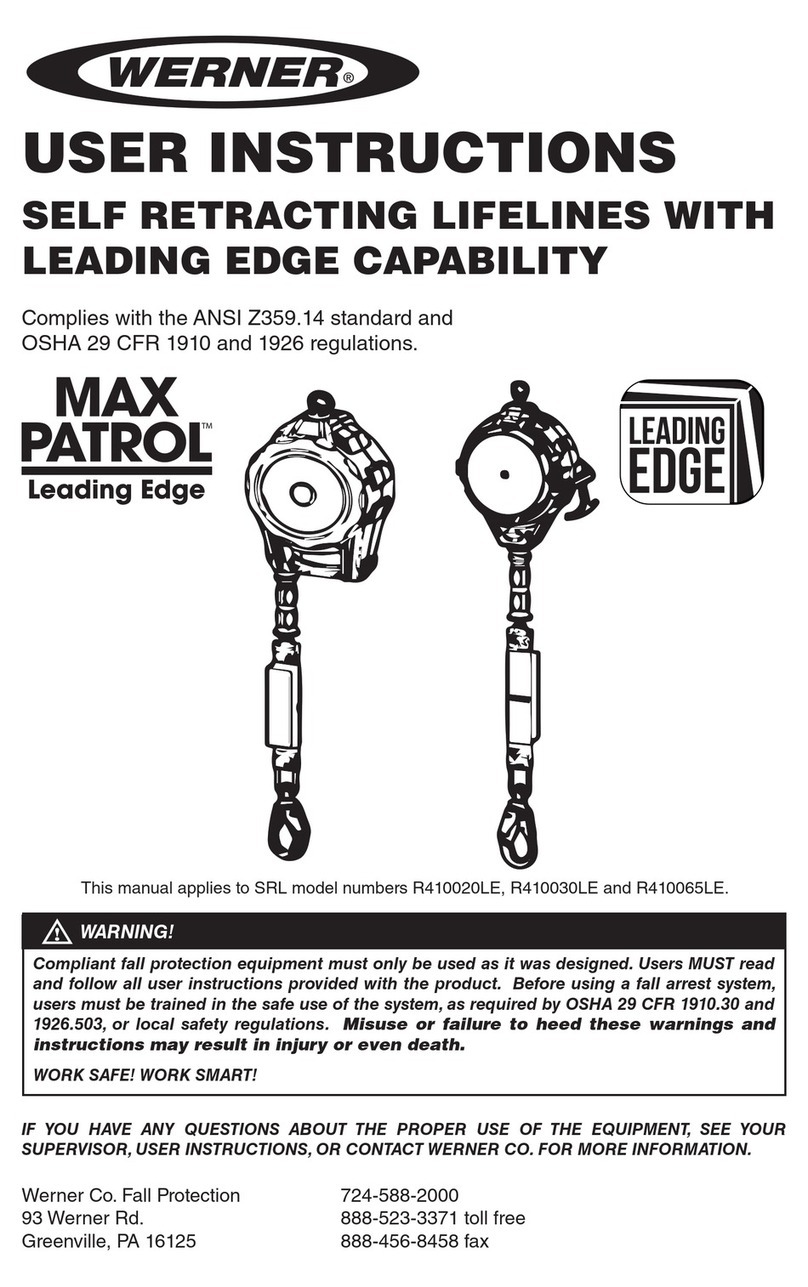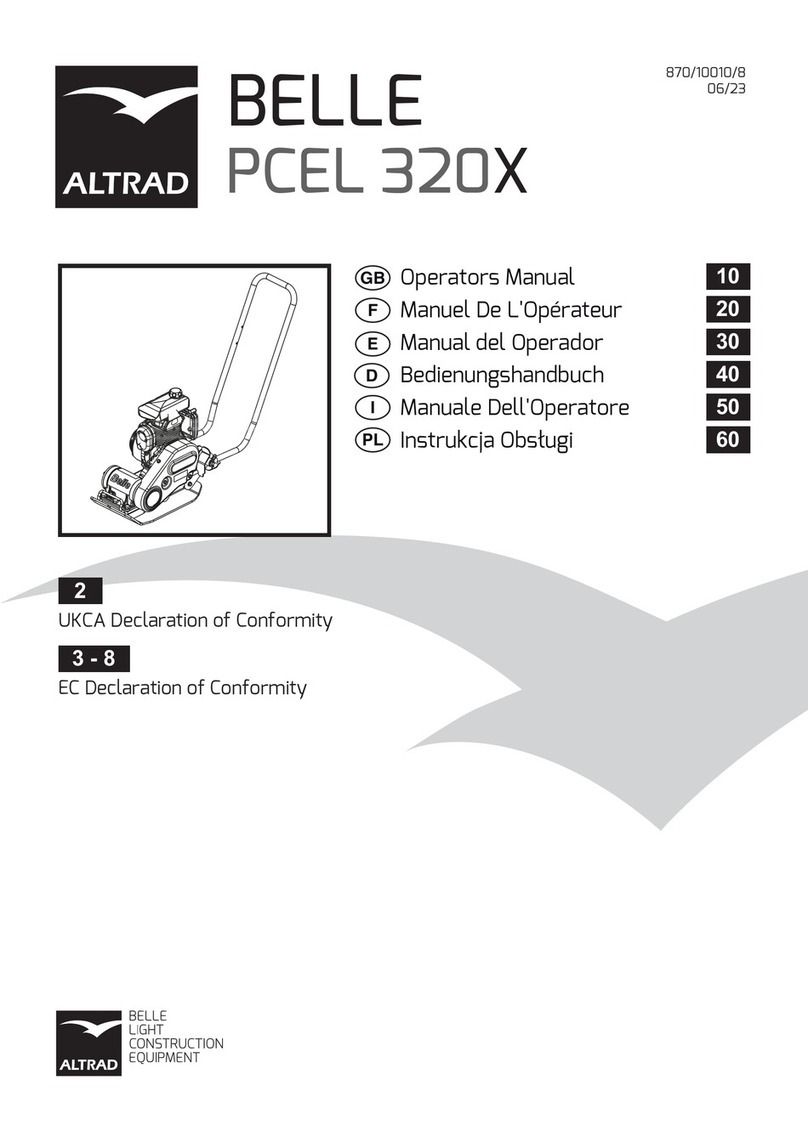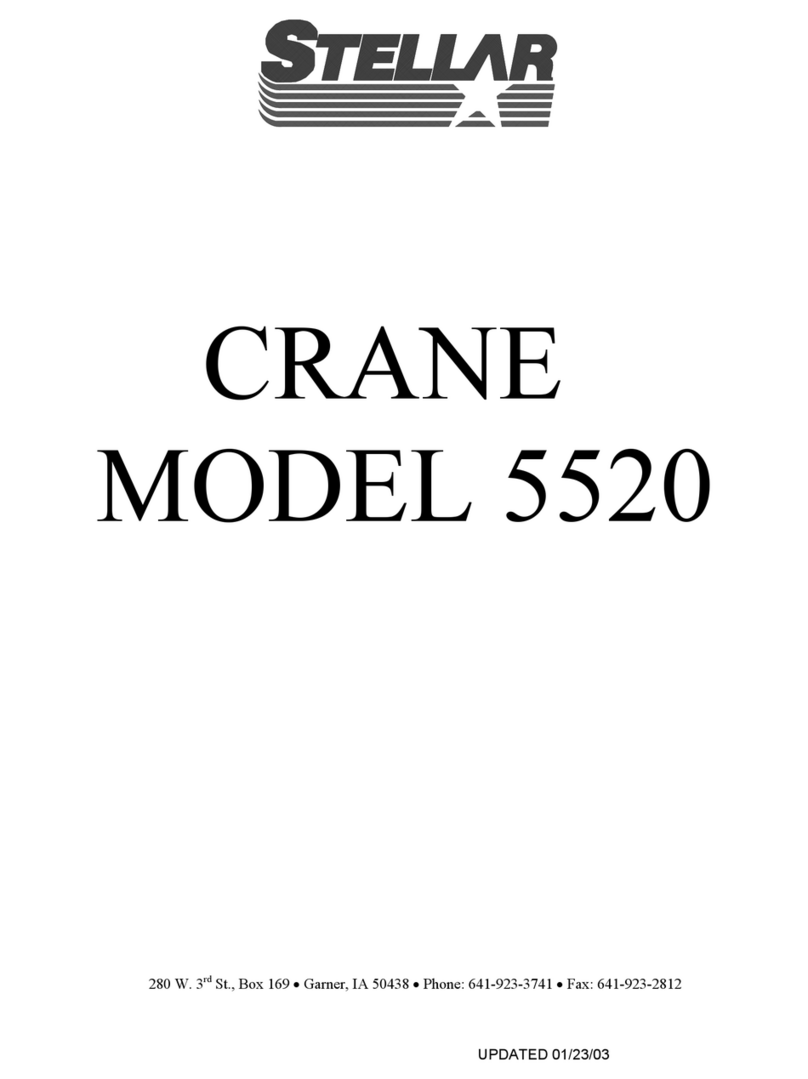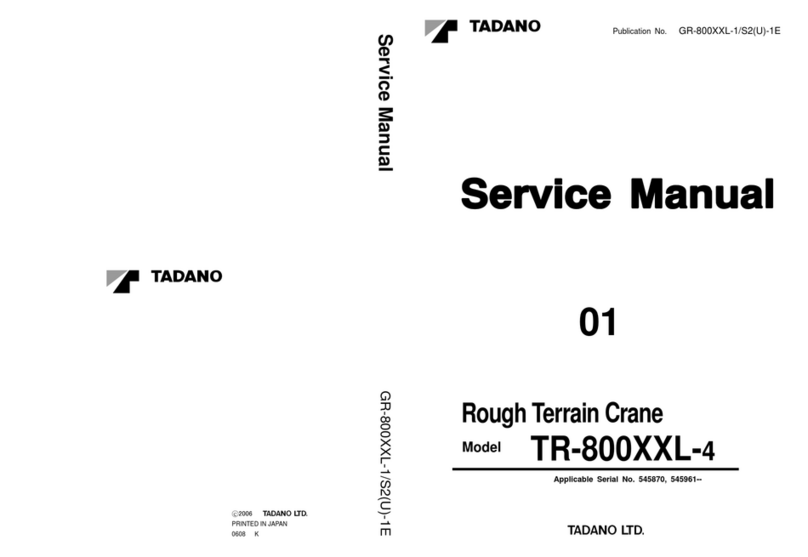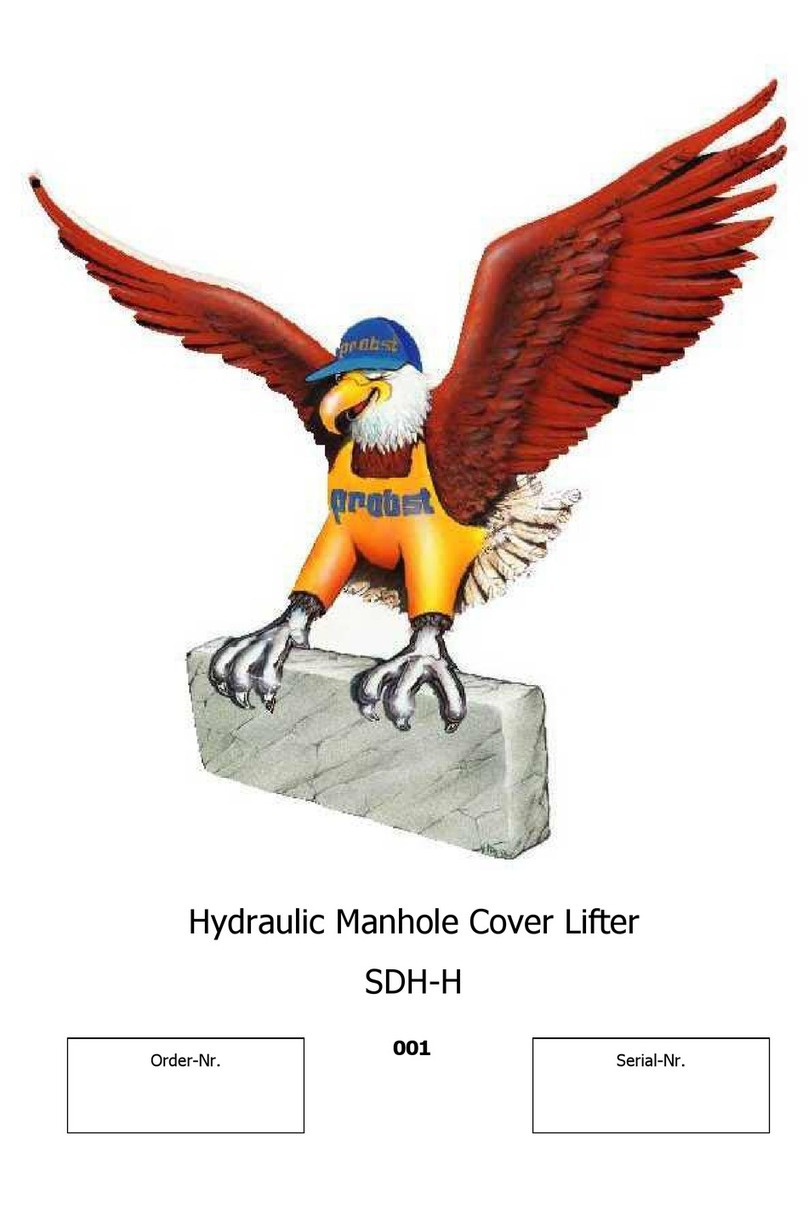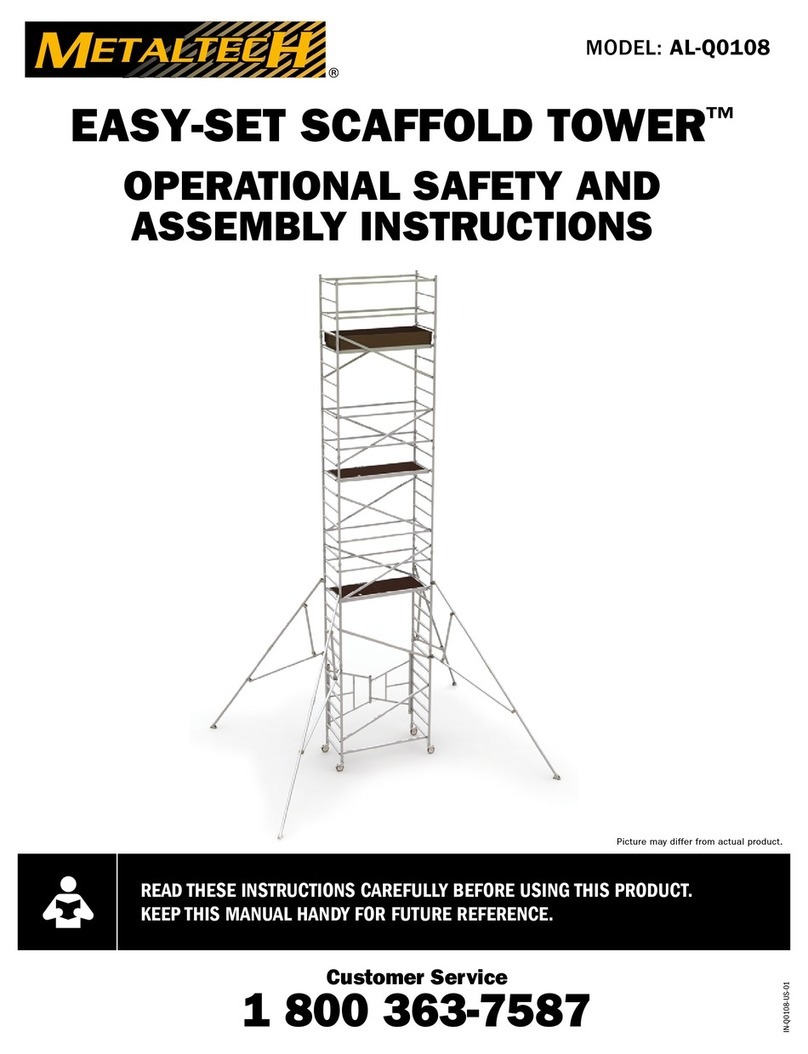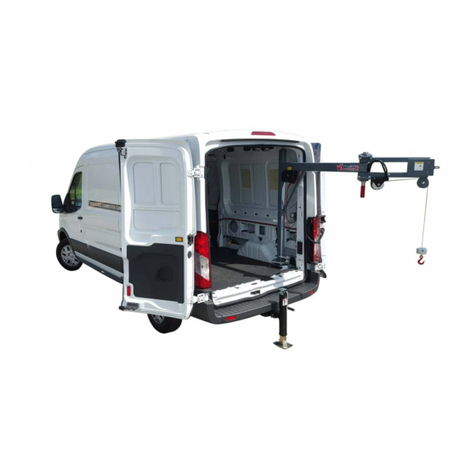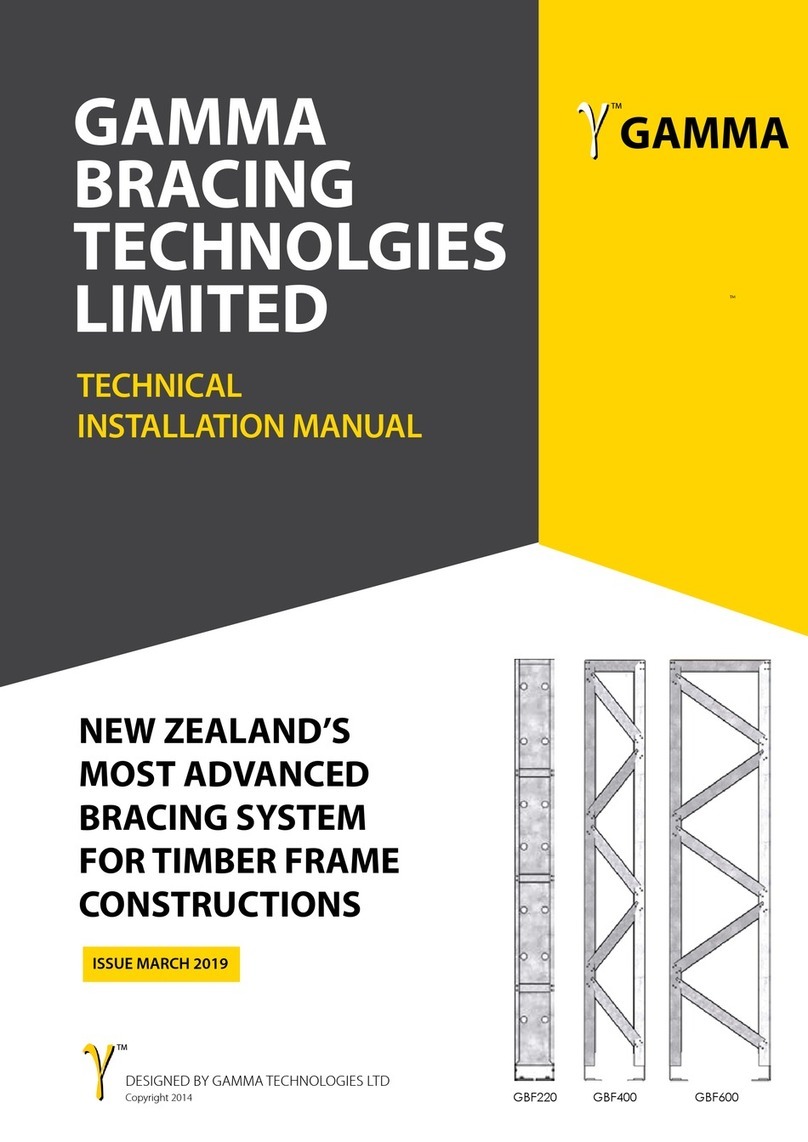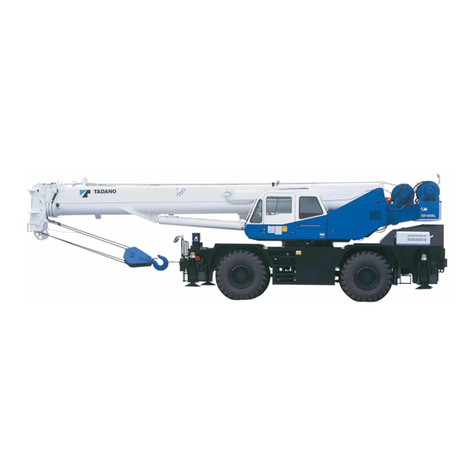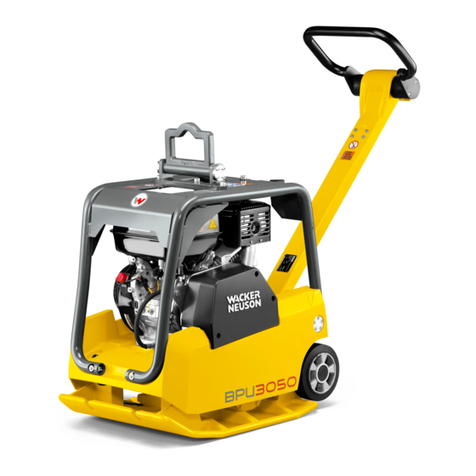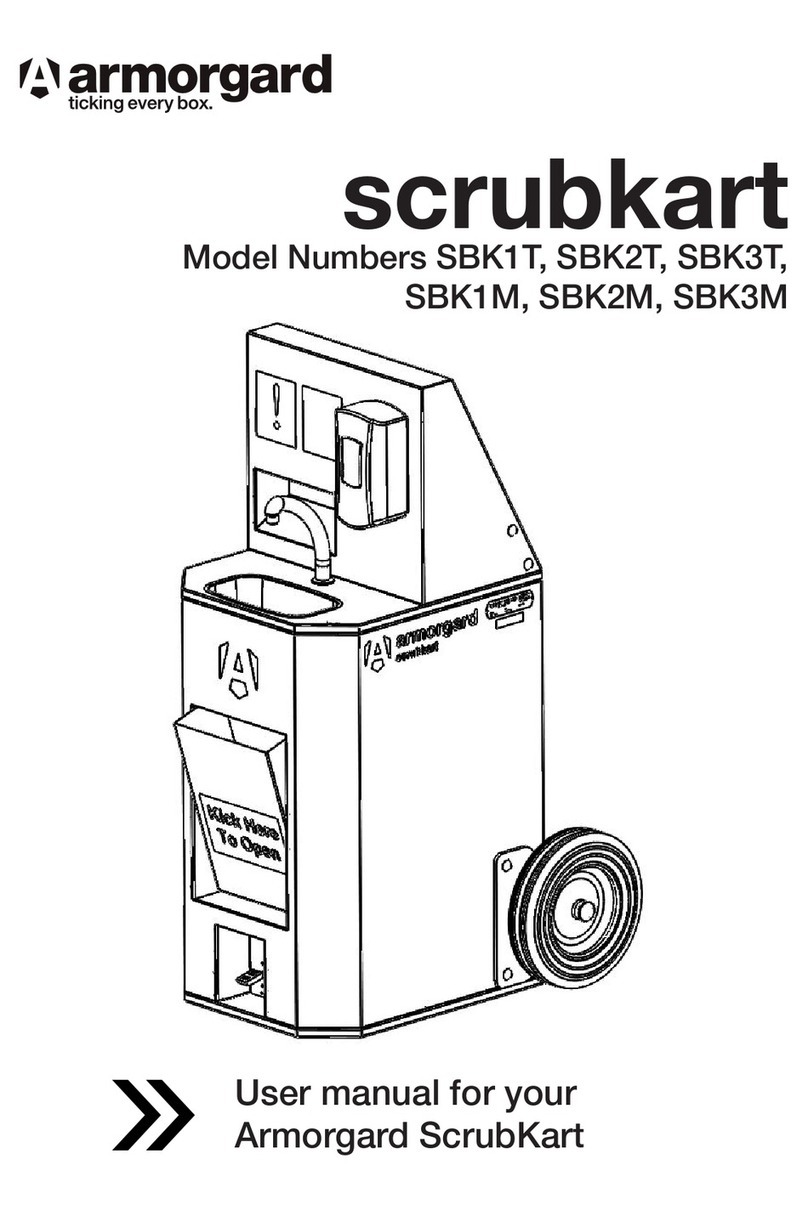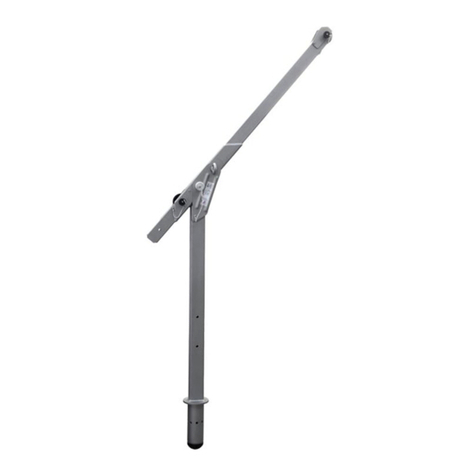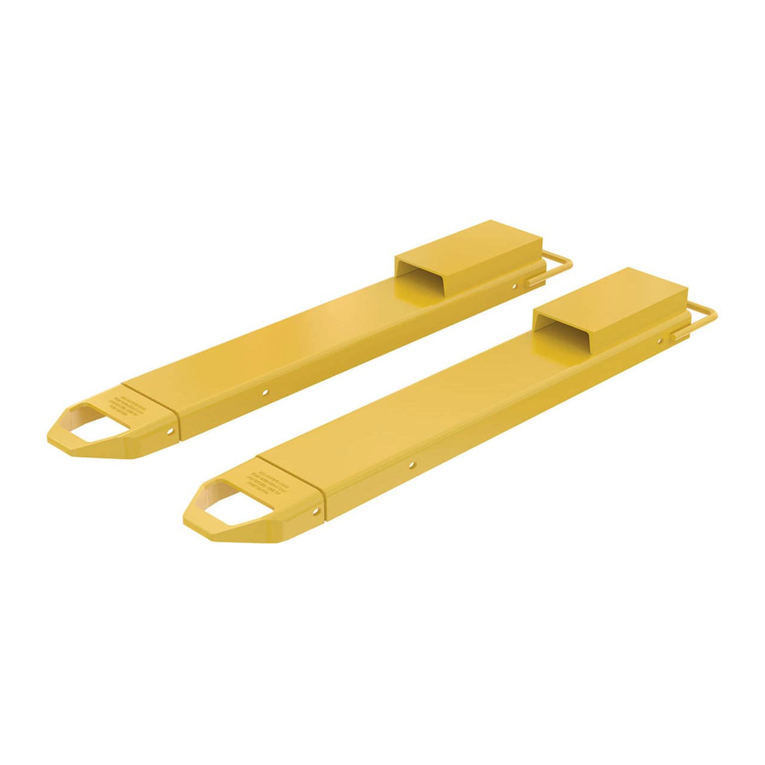Werner A513000XR User manual

Reusable Bolt Anchor
5,000-lbf / 22kN
Model: A513000XR
Assembled in the USA
V1.0-C
INSPECTION AND MAINTENANCE LOG
Part Number
MODEL NUMBER:
DATE OF MANUFACTURE:
Comments Inspector Name
Inspection:
Ocial periodic inspection must be made at least annually. The inspection must
be performed by a competent or qualied person other than the user. If severe
environmental conditions exist then inspections must be carried out more frequently.
All inspection results must be logged in the space provided above.
1. Inspect unit for visible signs of damage or wear that could aect operation. For
example: kinked or frayed cables.
2. Ensure all labeling is axed to the unit.
3. Check spoons and end termination operate smoothly with no metal burrs.
4. When reusing a previously drilled hole, inspect for debris or wallowing.
5. Record inspection results in the space provided above.
* If inspection reveals any damage that could aect the strength or operation
of the device, inadequate maintenance, or an unsafe condition, proper disposal
is required. The anchorage connector must be rendered unusable and then
properly discarded.
Werner Co.
93 Werner Road
Greenville, PA 16125
1(888) 523-3371 / www.wernerco.com
P/N 105545-03 Rev D 4/21
Date
WARNING: ALL USERS OF THIS EQUIPMENT MUST READ AND
UNDERSTAND ALL INSTRUCTIONS. FAILURE TO DO SO MAY
RESULT IN SERIOUS INJURY OR DEATH. USERS SHOULD BE
FAMILIAR WITH PERTINENT REGULATIONS GOVERNING THIS
EQUIPMENT. ALL USERS OF THIS PRODUCT MUST BE PROPERLY
INSTRUCTED ON HOW TO USE THE DEVICE. AVOID CONTACT
WITH PHYSICAL HAZARDS (THERMAL, CHEMICAL, ELECTRICAL,
ETC.). MAKE ONLY COMPATIBLE CONNECTIONS.
Patent # US 7,357,363 B2 / US 7,011,281 B2 / US 6,729,821 B2
User Instructions must always be available to the user and are not to be removed except by the user of this equipment. For proper use, see
supervisor, User Instructions, or contact the manufacturer. Werner Co. can supply additional information upon request.
Compliant fall arrest and emergency rescue systems help prevent serious injury during fall arrest. Users and purchasers of this equipment must read
and understand the User Instructions provided for correct use and care of this product. All users of this equipment must understand the instructions,
operation, limitations and consequences of improper use of this equipment and be properly trained prior to use in accordance with applicable
standards. All references to“applicable standards”refer to ANSI, OSHA, state, local, and/or federal standards that apply to approved use. The local
competent person must keep these instructions, make them available to users, and require their use.
Misuse or failure to follow warnings and instructions may result in serious personal injury or death.
PURPOSE
The A513000XR are anchorage connectors designed to function as an interface between the anchorage and a fall arrest, work positioning, rope
access, or rescue system for the purpose of coupling the system to the anchorage. Any references to“anchorage connector” in this manual include,
and apply to, the A513000XR.
USE INSTRUCTIONS
1. A user must be of sound mind and body to properly and safely use this equipment in normal and emergency situations.
2. Before using a personal fall arrest system, user must be trained in accordance with the requirements of applicable standards in
the safe use of the system and its components.
3. Only use with systems that comply with applicable standards. The anchorage must have the strength capable of supporting a static
load, applied in the directions permitted by the system, of at least 5,000-lbf (22kN) in the absence of certication.
4. The user shall be equipped with a means of limiting the maximum dynamic forces exerted on the user during the arrest of a fall
to a maximum of 8 kN (1800-lbf). In the EU these forces must be limited to 6 kN (1350-lbf).
5. Use of this product must be approved by an engineer or other qualied person (as dened by OSHA 29 CFR 1926.32 (m)) to be
compatible with any and all structural & operational characteristics of the selected installation location and system to be connected to
this anchorage connector.
6. The anchorage connector must be inspected prior to each use for wear, damage, and other deterioration. If defective components
are found, the anchorage connector must be immediately removed from service in accordance with applicable standards and the
manufacturer’s inspection requirements.
7. The anchorage connector should be positioned in such a way that minimizes the potential for falls and the potential fall distance
during use. The complete fall arrest system must be planned (including all components, calculating fall clearance, and
swing fall) before using.
8. A rescue plan, and the means at hand to implement it, must be in place that provides the prompt rescue of users in the event of
a fall, or assures that users are able to rescue themselves.
9. After a fall occurs, the anchorage connector must be removed from service and destroyed immediately.
USE LIMITATIONS: This anchorage connector has been tested in compliance with the requirements of ANSI/ASSE Z359.7. Compliance testing covers
only the hardware and does not extend to the anchorage and substrate to which the anchorage connector is attached. The anchorage connector
must not be used outside its limitations or for any purpose other than that for which it is intended. If this anchorage connector is used dierently
from these instructions, it must be designed, installed, and used under the supervision of an engineer according to ANSI Z359.6 and local building
codes as applicable.
1. The anchorage connector is designed for single user.
2. The anchorage connector may be pulled in any direction shown in the PROPER LOADING diagram.
3. The anchorage connector is designed to be used in temperatures ranging from -40ºF to +130ºF (-40°C to +54°C).
4. Do not expose the anchorage connector to chemicals or harsh solutions which may have a harmful eect.
5. Do not alter or modify this product in any way.
6. Caution must be taken when using any component of a fall arrest, work positioning, rope access, or rescue system near
moving machinery, electrical hazards, sharp edges, or abrasive surfaces, as contact may cause equipment failure, personal
injury, or death.
7. Do not use/install equipment without proper training by a “competent person” as defined by OSHA 29 CFR 1926.32(f ).
8. Do not remove the labeling from this product.
9. Additional requirements and limitations may apply depending on anchorage type and fastening option utilized for installation.
All placements must be approved by an engineer or other qualied person.
10. This anchorage connector should not be used as part of a horizontal lifeline system that has not been designed and/or
approved to be used with 5,000-lbf anchorage connectors.
11. The anchorage connector should only be used as intended (see PURPOSE).
12. If attaching the anchorage connector to the support structure by methods other than instructed, the attachment must be certied by a
qualied person to meet the requirements of the system that will connect to the anchorage connector.
COMPATIBILITY LIMITATIONS
Anchorage connector must only be coupled to compatible connectors. OSHA 29 CFR 1926.502 prohibits snaphooks from being engaged to certain
objects unless two requirements are met: it must be a locking type snaphook, and it must be “designed for”making such a connection. “Designed
for” means that the manufacturer of the snaphook specifically designed the snaphook to be used to connect to the equipment listed. The following
connections must be avoided, because they can result in rollout* when a nonlocking snaphook is used:
• Direct connection of a snaphook to horizontal lifeline.
• Two (or more) snaphooks connected to one D-ring.
• Two snaphooks connected to each other.
• A snaphook connected back on its integral lanyard.
• A snaphook connected to a webbing loop or webbing lanyard.
• Improper dimensions of the D-ring, rebar, or other connection point in relation to the snaphook dimensions that would allow the
snaphook keeper to be depressed by a turning motion of the snaphook.
*Rollout: A process by which a snaphook or carabiner unintentionally disengages from another connector or object to which it is
coupled. (ANSI Z359.0-2007)
MAINTENANCE, CLEANING AND STORAGE
Cleaning periodically will prolong the life and proper functioning of the product. The frequency of cleaning should be determined by inspection and
by severity of the environment. Clean with compressed air and/or a sti brush using plain water or a mild soap and water solution. Do not use any
corrosive chemicals that could damage the product. Wipe all surfaces with a clean, dry cloth and hang to dry, or use compressed air. When not in use,
store anchorage connectors in a cool, dry, clean environment, out of direct sunlight and free of corrosive or other degrading elements.
Read This Instruction Manual Carefully Before Using This Equipment.

TAP!!!
drill .75 inch Ø (A) inch
min from any edge
(B) inch
DO NOT REMOVE
WARNING LABEL!
May be used as an anchor point for a leading edge
restraint system. See optional anchor points below for
example. The use of two anchors is not required for
leading edge restraint systems unless otherwise speci-
ed by the manufacturer.
WORK SURFACE
OPTIONAL
(ANCHOR POINTS)
WORK SURFACE
(ANCHOR POINT)
Concrete must be
3000-psi or higher and
fully cured. Installation
location to be approved
by a qualied person.
MINIMUM CLEARANCE 2 feet (.6m)
DECK/FLOOR/GROUND LEVEL
WARNING!!! SWING FALLS MAY OCCUR WHEN THE WORKER IS NOT DIRECTLY UNDER ANCHOR POINT.
All products subjected to fall arresting forces should be removed
from service immediately!
DRILLING & INSTALLATION INSTRUCTIONS:
1. Drill a .75 inch (20mm) diameter hole at least 3.5 inches (89mm) deep. The drilled hole must be straight and per
pendicular to the surface. Make sure the hole is of uniform diameter and free of peaks and valleys on the inner wall.
2. Blow hole clean with compressed air.
3. Always inspect the hole carefully when reusing a previously drilled hole.
4. When placing anchor, place your thumb inside the anchor loop and your rst two ngers around the trigger.
Squeeze ngers and thumb together till the trigger and spring fully compress.
5. Insert unit at least 3 inches (76 mm) deep into hole and release the trigger. Do not force.
6. Set the unit with a slight tug on the anchor loop.
REMOVAL INSTRUCTIONS:
1. When removing anchor, place your thumb inside the anchor loop
and your rst two ngers around the trigger. Squeeze ngers and
thumb together until the trigger and spring fully compress.
2. While squeezing the trigger, pull the anchor out of the hole.
3. If the anchor becomes stuck, lightly tap the hole plug while squeezing
on the trigger to release.
4. If tool was required to remove the anchorage, inspect thoroughly
for damage after removal. If damage is found, remove from service
and destroy immediately.
*The user shall be equipped with
a means of limiting the maximum
dynamic forces exerted on the
user during the arrest of a fall to a
maximum of 8 kN (1800-lbf). In the
EU these forces must be limited
to 6 kN (1350-lbf).
Compliance: OSHA 29 CFR 1926.502, OSHA 29 CFR
1910.140, ANSI Z359.18 Type A, ANSI Z359.7(19)
Removable Bolt
Anchor
Model: A513000XR
Batch# XXXX
MFD: MM/YYYY
1(888) 523-3371
5,000-lbf (22kN) MBS
Pat # US 7,357,363 / 7,011,281 / 6,729,821
P/N 109811-04 REV F 4/21
WARNING: ALL USERSOFTHIS EQUIPM ENT MUST READ AND
UNDERSTAND ALLINSTRUCTIONS. FA ILURE TO DO SO MAY
RESULT IN SERIOUS INJURY OR DEATH. USERS SHOULD BE
FAMILIAR WITH PERTINENTREGULATIONS GOVERNINGTHIS
EQUIPMENT.ALL USERSOFTHISPRODUC TMUSTBEPROPERLY
INSTRUCTEDONHOW TO USETHE DEVICE.AVOID CONTACT
WITH PHYSICAL HAZARDS (THERMAL,CHEMICAL, ELECTRICAL,
ETC.). MAKE ONLY COMPATIBLE CONNEC TIONS.
1.25 inches
(31.5mm)
Cleaning Bushing
5inches (127 mm)
End Termination
Stop Sleeve
Spring
End Termination
11.75 inches (298.5 mm)
Heavy Duty Return Wire
Trigger
Anchor Loop
3.4 inches (86.4 mm)
3.15 inches (80 mm)
Spoon
Main Cable
Compliance: OSHA 29 CFR 1926.502, OSHA 29 CFR
1910.140, ANSI Z359.18 Type A, ANSI Z359.7(19)
Removable Bolt
Anchor
Model: A513000XR
Batch# XXXX
MFD: MM/YYYY
1(888) 523-3371
5,000-lbf (22kN) MBS
Pat # US 7,357,363 / 7,011,281 / 6,729,821
P/N 109811-04 REV F 4/21
WARNING:
ALL USERSOFTHIS EQUIPMENT MUST READ AND
UNDERSTAND ALLINSTRUCTIONS. FA ILURE TO DO SO MAY
RESULT IN SERIOUS INJURY OR DEATH. USERS SHOULD BE
FAMILIAR WITH PERTINENTREGULATIONS GOVERNINGTHIS
EQUIPMENT.ALL USERSOFTHISPRODUCTMUSTBEPROPERLY
INSTRUCTEDONHOW TO USETHE DEVICE.AVOID CONTACT
WITH PHYSICAL HAZARDS (THERMAL,CHEMICAL, ELECTRICAL,
ETC.). MAKE ONLY COMPATIBLE CO NNECTIONS.
HOLE DRILLING REQUIREMENT CHART
6 inches (15.3 cm)
12 inches (30.5 cm)
12 inches (30.5 cm)
5 inches (12.7 cm)
PERFORMANCE:
Minimum Breaking Strength (MBS):
5000-lbf (22kN)
Maximum Capacity: One worker when
used as a single point anchorage
connector for personal fall arrest or
restraint system
DIMENSIONS:
Weight: .44-lbs (200g)
Length: 11.75 inches (298.5mm)
Diameter 1.25 inch (31.5mm)
REGULATORY COMPLIANCE:
ANSI Z359.7-2019, ANSI Z359.18 Type
A OSHA 29 CFR 1926.502, OSHA 29 CFR
1910.140
COMPONENT MATERIALS:
Aluminum: Trigger
Aircraft Cable: Main Cable, Activator Wire
Stainless Steel: Cone, Spoons, Stop
Sleeve, End Termination , Cleaning Ferrule
Zinc Plated Steel: Spring , Hole Plug,
Anchor Loop
90º
90º
0º
PROPER LOADING
Good
Best
See Spoon Orientation
Good
See Spoon Orientation
*Best practice for spoon orientation
when loaded 90º to hole.
SPOON ORIENTATION
Best
Ok
Load
Load
=
=
(A) inch Minimum distance from edge/corner (B) inch Concrete thickness
Other Werner Construction Equipment manuals

